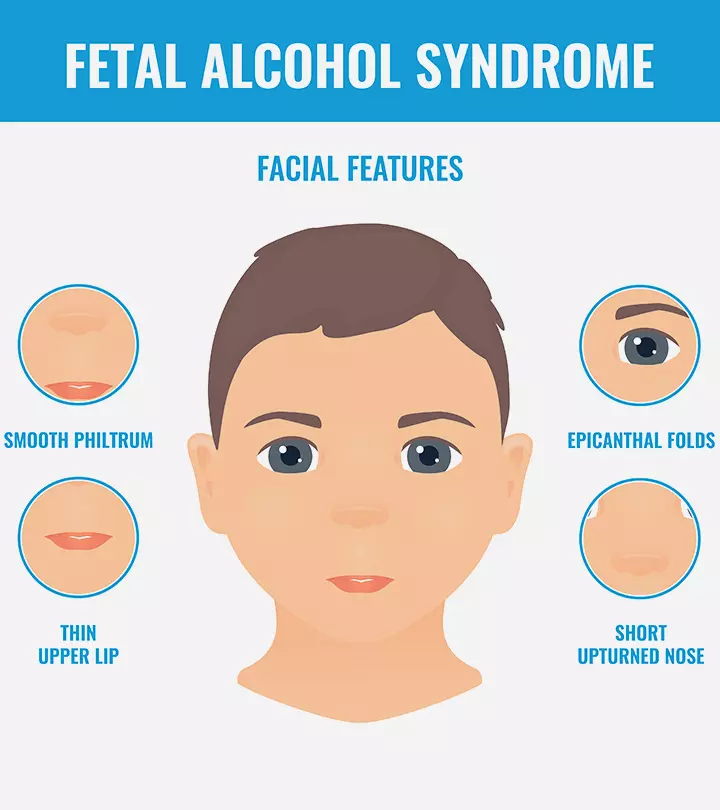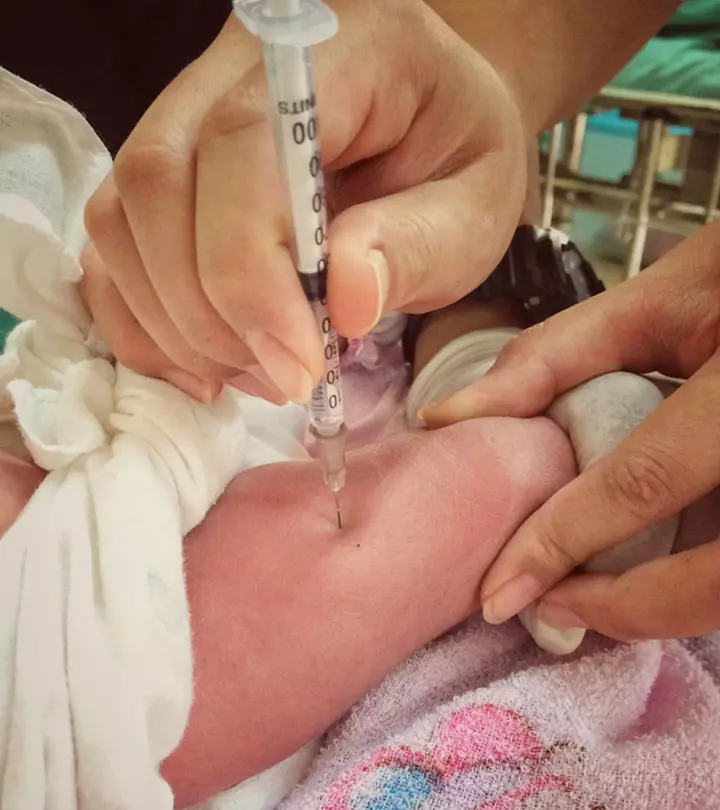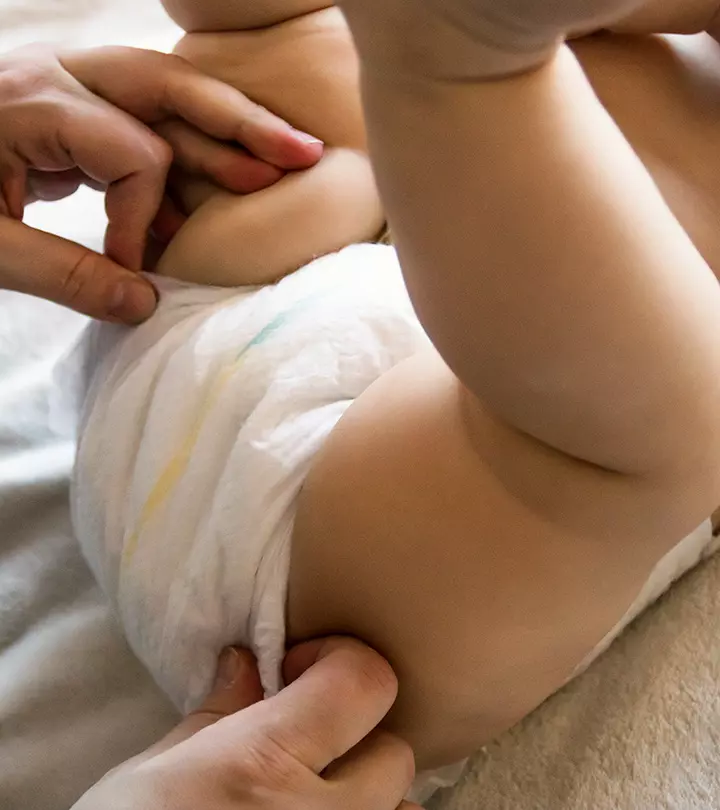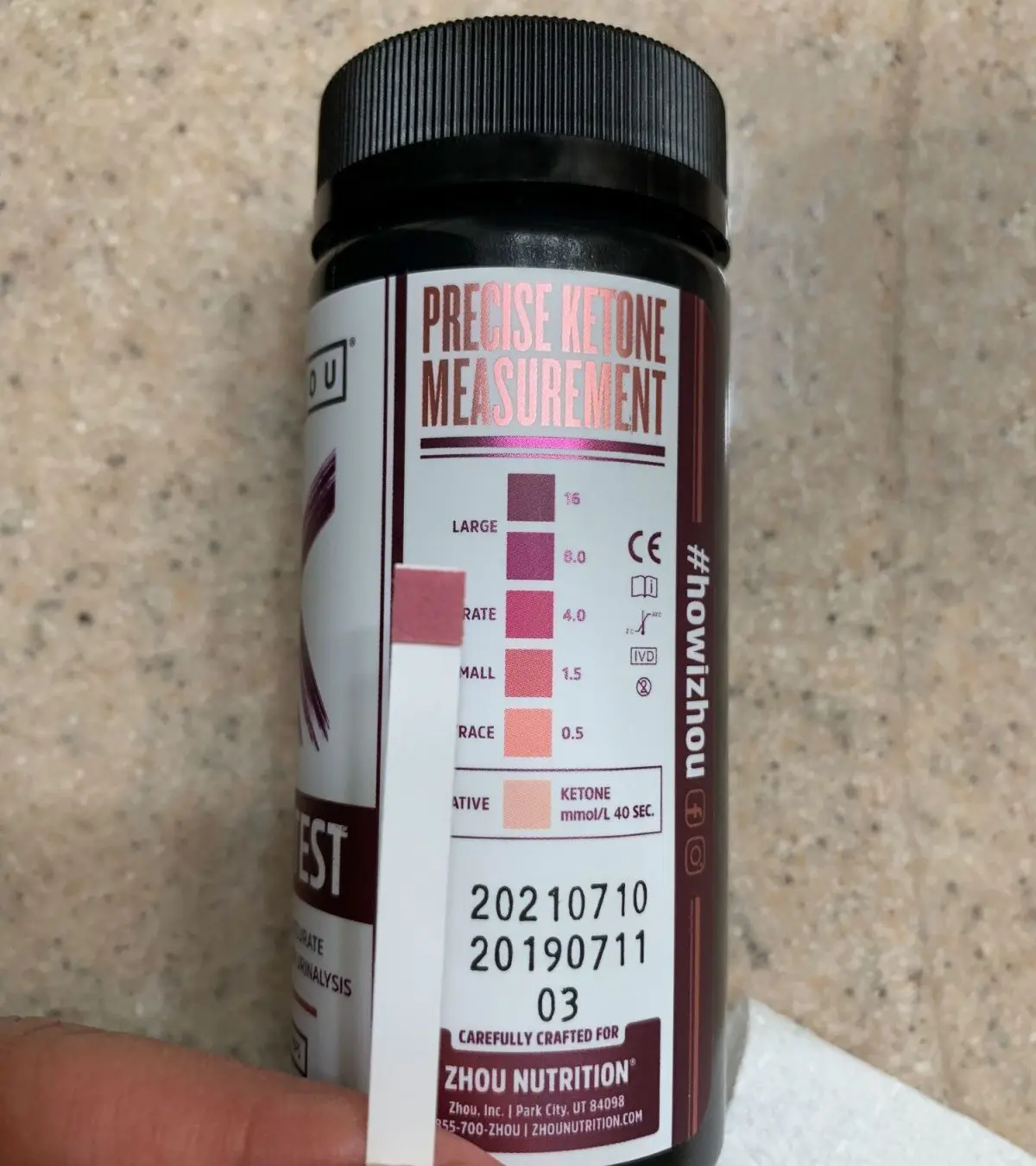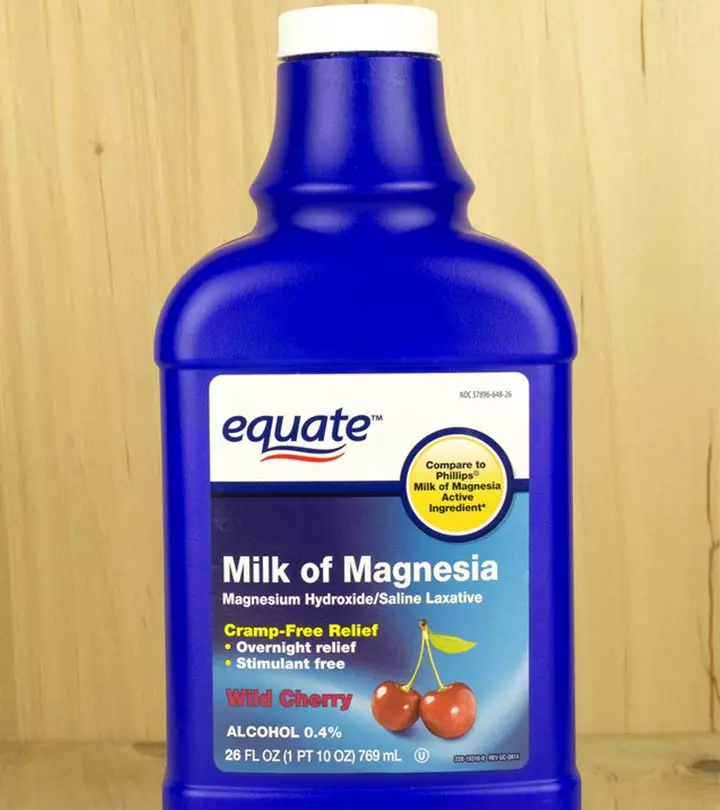
Image: Midjourney/ MomJunction Design Team
Fontanelles (or fontanels) are gaps between the skull bones of a newborn. A normal fontanelle feels firm and is slightly curved inwards. A baby’s sunken fontanelle may feel sunken or soft which is a cause for concern. Fontanelles are formed when two or more cranial bones (cranial bones or cranium refers to the bones that enclose and protect the brain) appear side by side. There are six fontanelles in a newborn’s skull, which are located on the top, back, and sides of the head and behind the eyes. They make the baby’s skull flexible enough to pass through the birth canal and allow the brain to grow in size with the growing skull. The molding process of the skull continues for several months after birth before these soft spots close. The average time for closure is between 12 to 18 months (1). The fontanelle at the back may close at around one to two months old, while the one in the front, often called the soft spot, is the last to close at around seven to 19 months (2). Read this post to learn about the signs, causes, diagnosis, treatment, and prevention of sunken fontanelle in babies.
Key Pointers
- Fontanelles are gaps between the skull bones that make a baby’s skull flexible enough to pass through the birth canal and provide ample space for the brain to grow.
- If a baby has soft spots sunken inwards, looking like a dent on the skull, it may indicate an underlying problem.
- Dehydration is the main reason for a baby to have sunken fontanelles. However, several other reasons, such as early or delayed closure of the fontanelles, could also play a role.
- Timely diagnosis and cause-based treatment can help resolve the problem in most cases.
- Unless an underlying medical condition is a cause, sunken fontanelles can be prevented by keeping the baby well-nourished and optimally hydrated.
Signs Of Sunken Fontanelle
As your child grows, the soft spots begin to harden, and the gaps tend to close. But if you find your baby’s soft spot sunken inwards and resembles a dent or depression on their head, it could be a sunken fontanelle.
A sunken fontanelle could also be a sign of dehydration or malnutrition; so, you may also find signs including lethargy, dry mucous membranesiThe moist inner lining of organs like the nose, mouth, lungs, and stomach , and low urine output (2).
Dr. Wendy Sue Swanson, a mom and a pediatrician, shares her experience of being worried about her baby’s fontanelle on her blog. She says, “You’re not alone if you find yourself thinking/worrying about the soft spot at 2 a.m. When O was born, I asked his pediatrician at two separate visits to reassure me about his soft spot. It just felt big! I think she thought I was crazy. I remember feeling embarrassed to bring it up (thinking she would think I should know better) even though I was worried about it. She reassured me. He was growing well, his head was growing well, and he was doing what he was supposed to do (ⅰ).’’
Causes Of Sunken Fontanelle
Abnormalities of the fontanelle such as bulging, sinking, large size, small size, and early or delayed closures need attention. Below are some possible reasons for sunken fontanelle in babies.
1. Dehydration
The fontanelle of a well-hydrated baby appears flat and firm. One of the primary reasons for sunken fontanelle is dehydration. Poor feeding or loss of excess water from the body could result in dehydration. Other symptoms of dehydration include
- Yellow urine
- Dry mouth
- Less or no wet diapers
- Sunken eyes,
- Dry lips
- Dry mucous membranes (3)
 Point to consider
Point to consider2. Malnutrition
MalnutritioniA condition that develops due to a lack of proper food or nutrients in the body can also cause a sunken fontanelle. If your baby shows poor weight gain and asymmetric growth, it could cause sunken fontanelle. Other signs of malnutrition include
- Fatigue,
- Weakness
- Lethargy
- Dry and inelastic skin
- Failure to thrive (3)
3. Diabetes insipidus
Sometimes, the dehydration can be due to an underlying medical condition, such as diabetes insipidusiAn uncommon disorder that causes an imbalance of hormones in the body characterized by heavy thirst and urination , which could lead to sunken fontanelle. The symptoms of diabetes insipidus are similar to diabetes mellitusiA condition in which the body is unable to take more sugar or glucose into the cells , except that the urine may not contain high sugar levels. Other symptoms include
- Extreme thirst
- Excessive urination,
- Dry skin
- Weight loss
- Muscle pain
- Rapid heart rate
- Fatigue (4)
4. Kwashiorkor and Marasmus
The deficiency of protein and energy may also cause sunken fontanelle in babies. KwashiorkoriAn extreme form of malnutrition among babies characterized by delayed growth, swollen stomach, and frequent infections and marasmusiAn extreme protein and energy deficiency resulting from a lack of calorie intake among children are two of the main conditions associated with the insufficient intake of proteins and calories. These are characterized by irritability, lack of interest, and sunken fontanelle in babies. Additional symptoms include sunken groins, buttocks, face, and thighs (5).
 Research finds
Research findsA baby’s sunken fontanelle can be felt with the hand. It will appear soft and like a dent on the head. Along with this, if you find additional symptoms of dehydration or malnutrition, talk to your pediatrician as it could be a medical emergency.
Diagnosis Of Sunken Fontanelle
The doctor might do a physical examination and examine and feel the area to determine any abnormalities in the structure of the fontanelle. The doctor may also examine the baby’s heart rate, breathing, and skin condition for signs of dehydration or malnutrition.
Next, the doctor would ask questions to determine if they are suffering from dehydration or malnutrition. The questions could revolve around the baby’s feeding habits and whether they are urinating normally.
After knowing the case history, the doctor may prescribe tests to determine the underlying medical condition causing sunken fontanelle. These tests may include
- Blood tests
- Urine analysis
- Complete blood count
- Tests to check the vitamin and iron content
 Quick fact
Quick factTreatment For Sunken Fontanelle
If the reason for the sunken fontanelle is dehydration, it needs immediate medical attention. The doctor might administer infant fluids orally. However, in cases of diarrhea or vomiting in babies, the fluids might be administered intravenously.
In case your baby is malnourished, the essential nutrient should be delivered slowly, keeping the calorie intake at 60–80% of the total requirement for the age (5). You may also consider nutritional counseling to create a tailored dietary plan for your baby.
Prevention Of Sunken Fontanelle
Unless there is an underlying medical condition involved, sunken fontanelle can be prevented. Ensure your baby is well-hydrated, and stick to the feeding schedule. If your baby has started consuming solids, then include nutritious foods in their diet.
When To Call The Doctor?
If your baby has feeding difficulties or shows signs of excess thirst, produces low urine, or is lethargic and shows abnormal vital signs, contact your pediatrician.
Dehydration and malnutrition in babies should be addressed as soon as possible because if neglected, it could lead to long-term complications. And even if your baby does not show a sunken fontanelle but fails to thrive or gain weight, it is best to consult your pediatrician. The experts at the Pregnancy, Birth and Baby states that, “If one or both of your baby’s fontanelles have not closed by the time they are 2 years old, speak to your doctor or pediatrician (6).”
Frequently Asked Questions
1. Can crying cause sunken fontanelle?
No, on the contrary, when an infant cries, their fontanelle may appear to be bulging (7).
2. What happens if fontanelle closes late?
According to experts, delayed fontanelle closure can indicate an underlying medical issue, such as hypothyroidism or Down syndrome (8). Parents must speak to a doctor if the baby’s fontanelles don’t close by 18 months of age.
Baby’s sunken fontanelle is a condition where you may notice a dented skull. The appearance can be concerning, but timely treatment can help manage the condition. Since the occurrence is primarily due to dehydration and sometimes malnutrition, adequate fluid intake and a properly balanced diet should help prevent this condition in babies. However, the condition may also indicate underlying morbidity that usually presents characteristic symptoms. Irrespective of the cause, after you identify sunken fontanelle in your baby, consult your doctor promptly to avoid adverse outcomes.
Infographic: What Information Does An Infant’s Fontanelle Give?
Fontanelle or soft spot changes indicate an infant’s brain development and general health status. A few changes may occur due to health conditions that require prompt medical care. Here is an infographic to learn more about the various fontanelle changes in babies and what they mean.

Illustration: Momjunction Design Team
Personal Experience: Source
MomJunction articles include first-hand experiences to provide you with better insights through real-life narratives. Here are the sources of personal accounts referenced in this article.
ⅰ. Science Of The Soft Spot: The Anterior Fontanelle, Part 1.https://www.wendysueswanson.com/science-of-the-soft-spot-the-anterior-fontanelle-part-1/
References
1. Mohammed Oumer, et al.; Anterior fontanelle size among term neonates on the first day of life born at University of Gondar Hospital, Northwest Ethiopia; PLOS ONE (2018).
2. Fontanelles – sunken; University Of Florida Health
3. Joseph Kiesler and Rick Ricer; The Abnormal Fontanel; American Family Physician (2003).
4. Diabetes Insipidus; Histiocytosis Association
5. Owuraku A. Titi-Lartey and Vikas Gupta; Marasmus; StatPearls (2020).
6. About the fontanelle; Pregnancy, Birth & Baby
7. Fontanelles – bulging; Medline Plus
8. Anterior and Posterior Fontanelle Closures; University of Colorado School of Medicine
9. Keeping Your Baby Hydrated During Summer; Children’s National
10. NA Kamaruzaman et al.; An infant with kwashiorkor: The forgotten disease; ; NCBI (2020)
11. Diagnosing Fluid & Electrolyte Disorders in Children; Hassenfeld Children’s Hospital
Community Experiences
Join the conversation and become a part of our nurturing community! Share your stories, experiences, and insights to connect with fellow parents.
Read full bio of Dr. Richard Mario Lurshay
Read full bio of Rohit Garoo
Read full bio of Dr. Ritika Shah
Read full bio of Vidya Tadapatri





